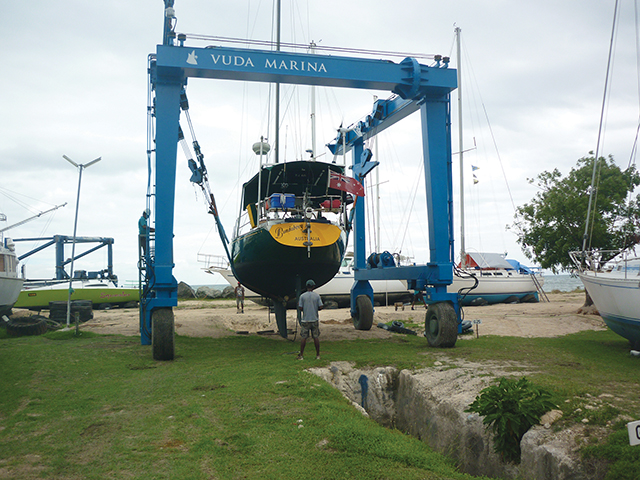An unexpected cyclone season hideout makes for a laborious but rewarding stop (published February 2014)
Kate was truly ready to stop when we arrived in Fiji. The engine troubles that had been plaguing us for the last 18 months hadn’t managed to fix themselves. After six thousand miles we were used to sailing into harbors, on and off anchor, and drifting on passage, but the channel in the reef was narrow and we had a 20-knot headwind. We had no choice but to motor in, puttering along at half a knot leaving a conspicuous cloud of black smoke in our wake. In the confines of the marina, my stress level skyrocketed, so many boats and so little power to maneuvre. I drove Steve crazy with my worries, pacing and incessant nervous chatter.
Stopping in Fiji wasn’t in the advanced plan, then again, we had only intended to take a year and half off work, and that was three years ago. With the end of the sailing season in sight, we needed to find a place to hide.
At first glance Fiji may not seem like a safe place to spend the summer in the South Pacific. At 17 degrees 40 minutes latitude south and 177 degrees 20 minutes longitude east, it is in the middle of the cyclone belt, and summer here is storm season. None of its 322 islands feature any of the “fjord like” harbors that guidebooks like to recommend as safe havens. In fact, most of the inlets and bays are riddled with shoals and reefs that cause mariners grief on even the calmest days.
Fiji, however, has a long maritime history, one that stretches back over 3,500 years. It was then, on the southwest shore of Viti Levu, Fiji’s main island, that the first ocean going sailing canoes made landfall. Local legend says that the explorers settled near the village of Viseisei, at what is now known as First Landing. Along the same stretch of beach that sheltered those intrepid explorers we found our refuge for the South Pacific storm season at Vuda Point Marina.
The marina has gained a word of mouth reputation in the sailing community as a safe haven and because of that, things book up fast. Yacht owners have two options; boats can stay in the water, med moored in the keyhole basin of the marina, or they can be hauled out and lowered into a “hurricane hole.” Happily, many insurance companies will continue to provide coverage for yachts berthed here during the cyclone season.
HAULING OUT
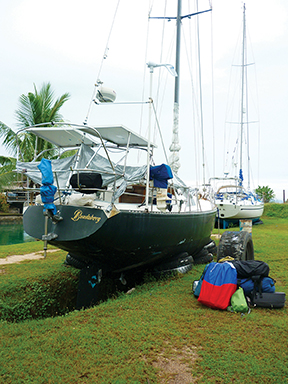 We chose to haul and were helped into the slipway by the marina dinghy where they secured the slings of the travel lift. After raising us up and a quick pressure wash and thorough inspection of the keel, we were transported across the yard and lowered into the hole. It is a trench really, narrow enough that Kate’s belly below the waterline rested on the edges, cushioned by tires, and deep enough that they have to shim up the keel with pieces of timber. There was just enough room to walk, stooped, underneath her where the air is damp and the mosquitos voracious. They raised and lowered Kate several times to make sure she was level and secure, even going so far as to make sure that the cockpit and deck drains were functioning properly so we wouldn’t flood if there was a storm. It is a task that takes considerable amount of time, skill and patience for the guys who run the yard, reflecting the care and attention that they give to each visiting yacht.
We chose to haul and were helped into the slipway by the marina dinghy where they secured the slings of the travel lift. After raising us up and a quick pressure wash and thorough inspection of the keel, we were transported across the yard and lowered into the hole. It is a trench really, narrow enough that Kate’s belly below the waterline rested on the edges, cushioned by tires, and deep enough that they have to shim up the keel with pieces of timber. There was just enough room to walk, stooped, underneath her where the air is damp and the mosquitos voracious. They raised and lowered Kate several times to make sure she was level and secure, even going so far as to make sure that the cockpit and deck drains were functioning properly so we wouldn’t flood if there was a storm. It is a task that takes considerable amount of time, skill and patience for the guys who run the yard, reflecting the care and attention that they give to each visiting yacht.
When they finally released the slings and backed the noisy travel lift away, we stood in silence, staring at our boat sitting high and dry awaiting the season’s worst. It is a macabre scene; a field of boats half buried in the earth, like rows of giant tombstones. To make things worse, they call this type of inground storage a “graveyard berth,” a term that makes me shudder with the thought of leaving our boat, our home, interred.
Our two greatest worries about leaving Kate were not damage from some fantastic storm, but two much smaller, yet still mighty, natural forces; mold and bugs. In the tropical heat, both can make quick inroads, but we’ve heard horror stories about boats unattended on land whose owners returned to fuzzy black walls and legions of cockroaches and ants. Our plan to prevent mold growth was to meticulously empty every compartment, hold, bilge and storage space, wash and wipe them down with vinegar to eliminate salt residue, then spray everything liberally with bug spray to prevent infestation. Everything that was removed would be washed in fresh water and hung to dry in the sun before being re-stowed.
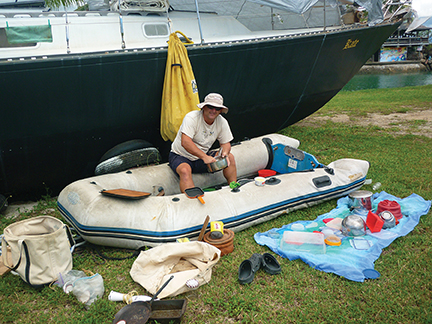 Wasting no time, Steve got busy unearthing the cockpit lockers while I started inside, carefully going through our food stores, emptying the galley of any unused or opened food stuffs. We packed all our books into plastic totes and all our clothes into large Ziplock bags. Together we washed, dried, packed, and debugged every line, sail, spare, toy, tool, towel, linen, dish and article of clothing on board. Nothing was left untouched, uncleaned or uninspected.
Wasting no time, Steve got busy unearthing the cockpit lockers while I started inside, carefully going through our food stores, emptying the galley of any unused or opened food stuffs. We packed all our books into plastic totes and all our clothes into large Ziplock bags. Together we washed, dried, packed, and debugged every line, sail, spare, toy, tool, towel, linen, dish and article of clothing on board. Nothing was left untouched, uncleaned or uninspected.
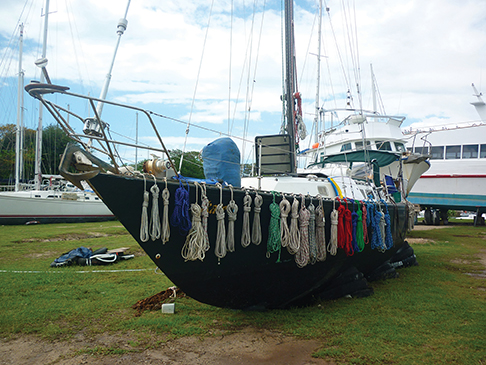 Then, according to marina regulations, and plain common sense, we went about stripping the deck; removing running rigging, taking down all the canvas and sails, stowing any unused or loose articles. Anything that could flap, chaff, break or become a projectile during a storm was tucked away or secured. It was a long and laborious process that was eased only by a seemingly unending supply of clean, fresh water on the dock and an icy cold beer at the sunset bar at the end of the day.
Then, according to marina regulations, and plain common sense, we went about stripping the deck; removing running rigging, taking down all the canvas and sails, stowing any unused or loose articles. Anything that could flap, chaff, break or become a projectile during a storm was tucked away or secured. It was a long and laborious process that was eased only by a seemingly unending supply of clean, fresh water on the dock and an icy cold beer at the sunset bar at the end of the day.
On the last afternoon we detached the boom and laid it on the cabin floor, emptied one last can of bug spray inside, heaved our luggage over the rail and shut the companionway boards. When we piled into the taxi, ten days after we arrived, I was still a ball of nerves. For the first time we were leaving behind our boat, our home, our lives. With a tear in my eye I reached across the dim back seat for Steve.
OUR RETURN
With our spirits buoyed and our luggage severely overweight, we returned to Fiji and our beloved Kate. It had been two weeks short of a year since we’d stowed the boat, packed our bags and temporarily turned our backs on our yachting life, six months longer than we’d intended. We had hired the help of a local man to look in on her, open the hatches, pump the bilges and monitor the batteries. He came recommended, but we had little communications with him over the year. I had survived by pushing aside worry and hoping that he was holding up his end of the bargain. As I undid the lock and opened up the boat, all that panicked energy came flooding back. But, I was pleasantly surprised; no whiff of mildew, no stale bilge smell, no black mold creeping up the walls and no nasty cockroaches scurrying across her sole. We both heaved a sigh of relief and let out a year’s worth of anxiety and nervous anticipation.
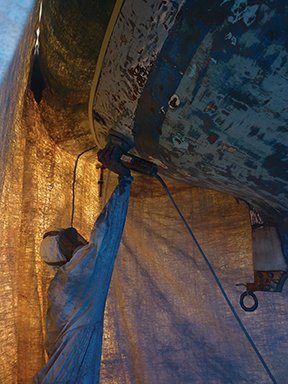 Since it was already October, we decided to spend another cyclone season in the hole, this time living aboard and tackling an ever-growing list of projects. Atop the list was the engine and engine bed; both needed dire attention before we set sail again. The backyard paint job done by a previous owner had looked bad before we left and after a year baking in the sun was embarrassing. We had talked about getting a proper arch built for our solar panels, the floor of the head was in need of a fiberglass repair, and the once beautifully varnished cabin sole now had, what we jokingly referred to as a “charming distressed look” to it. When we hauled out we noticed that the rudder needed some repair and now after 12 months of resting on the keel, it needed some too.
Since it was already October, we decided to spend another cyclone season in the hole, this time living aboard and tackling an ever-growing list of projects. Atop the list was the engine and engine bed; both needed dire attention before we set sail again. The backyard paint job done by a previous owner had looked bad before we left and after a year baking in the sun was embarrassing. We had talked about getting a proper arch built for our solar panels, the floor of the head was in need of a fiberglass repair, and the once beautifully varnished cabin sole now had, what we jokingly referred to as a “charming distressed look” to it. When we hauled out we noticed that the rudder needed some repair and now after 12 months of resting on the keel, it needed some too.
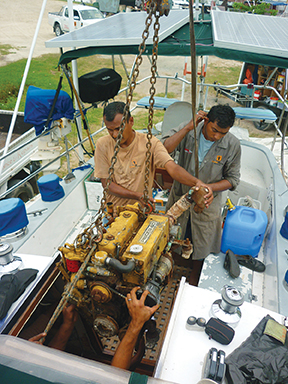 Thankfully, doing boat work in Fiji is easy and at Vuda Point Marina there are options for every budget. For the do-it-yourselfers there is a workshop with large tables, an assortment of basic tools and plenty of power points. For those wanting to hire someone, the marina office has a list of approved contractors, everything from unskilled laborers who work for an hourly wage to local companies that are knowledgeable and professional. Whether you need help with paint, fiberglass, welding, cabinetry, engine repair, sail repair, rigging, machining or fabrication, there is someone to help. It is also fairly easy to find supplies to do almost any job. If you can’t find the parts you need, you can import them with very little hassle and can qualify for duty free importation as a “Yacht in Transit.”
Thankfully, doing boat work in Fiji is easy and at Vuda Point Marina there are options for every budget. For the do-it-yourselfers there is a workshop with large tables, an assortment of basic tools and plenty of power points. For those wanting to hire someone, the marina office has a list of approved contractors, everything from unskilled laborers who work for an hourly wage to local companies that are knowledgeable and professional. Whether you need help with paint, fiberglass, welding, cabinetry, engine repair, sail repair, rigging, machining or fabrication, there is someone to help. It is also fairly easy to find supplies to do almost any job. If you can’t find the parts you need, you can import them with very little hassle and can qualify for duty free importation as a “Yacht in Transit.”
We set about getting quotes, arranging shipping and trying to balance the books. The initial work went fine and the major jobs we had contracted out were well on their way. The topside paint was completed, the engine and old sagging bed removed and replaced with a new custom-built engine bed and mounts, and the engine had been tuned up and the drive plate replaced. Steve and I had tackled many of the little projects and found several more to add to the list along the way. But, despite our progress, by the beginning of December, we were behind schedule.
The days were getting more humid and oppressive as summer blossomed, and like most places in the tropics, things in Fiji seemed to move along at their own pace. “Fiji Time” was getting harder to accept as an explanation to the latest delay, even if it was always accompanied by a smile. With Christmas fast approaching we decided to surprise Steve’s family back in Australia and to give ourselves a little break. Still living out of suitcases and the boat not yet unpacked, it was easier to leave this time. After a week in Australia we got reports about a giant tropical revolving storm moving towards Fiji; slowly heading in the direction of Vuda Point Marina.
There was nothing to do but cross our fingers and hope that now that our worst fears were realized, we would escape unscathed. Cyclone Evan turned out to be a category 4 storm whose eye passed within 50 NM of the marina. Fiji was battered with winds just outside the breakwater that were rumored to be clocked at 140 knots and power and telecommunications were interrupted for weeks. The marina staff had spent the week before the storm cleaning the yard, defoliating trees, securing boats and buildings. Largely due to their hard work there was minimal damage to most boats and the marina itself. Kate sustained some gouges in the new paint and lost a solar panel; we counted ourselves lucky.
The next several months floated by in a confusion of paint fumes and fiberglass dust. Like every boatyard, projects take twice as long as projected and require five times as much patience. The months of February and March were rainy, hampering progress on the paint job, which in turn held up several other projects. We started to get worried that we were running out of time. When entering Fijian waters yachts are given 18 months and in April our time would be up. Kate was far from seaworthy and we were far from finishing the mountain of work we were trapped under. With help from the marina and one of our contractors, we petitioned for an extension. The response from Fiji Customs and Revenue was a resounding “No problem!” We just had to pay a temporary import fee. There would be no exceptions, weather delays or not, and so with a resigned smile we bought a few more weeks and prayed for a change in the weather.
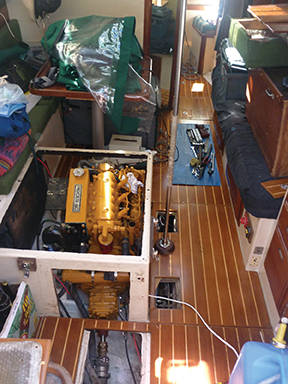 Our break finally came after much struggle and frustration. The to do list was ticked off fast and furiously. The weather held and the paint job was completed, including a fresh coat of antifouling. The rudder was fixed and fitted, the engine was squared up on the new engine mounts and rewired, the new to us transmission was installed and we were finally ready for sea trials. The new dodger, bimini and sail cover I promised to make got finished and the newly refinished cabin sole was laid down. Finally, our suitcases got unpacked. After more than six months our little boat started to feel less like a construction zone and more like a home.
Our break finally came after much struggle and frustration. The to do list was ticked off fast and furiously. The weather held and the paint job was completed, including a fresh coat of antifouling. The rudder was fixed and fitted, the engine was squared up on the new engine mounts and rewired, the new to us transmission was installed and we were finally ready for sea trials. The new dodger, bimini and sail cover I promised to make got finished and the newly refinished cabin sole was laid down. Finally, our suitcases got unpacked. After more than six months our little boat started to feel less like a construction zone and more like a home.
The morning of our departure Steve and I stood at the bow. Gathered on shore was most of the marina staff, all of whom we knew by name. A few of the men played guitars and everyone sang in Fijian. Their serenade was a blessing, wishing us a safe journey and inviting us to return. Steve gave me a quick kiss on the cheek before heading back to the cockpit to back us out. I pulled in the lines on the bow as I blinked back tears. I was physically exhausted from months of working on the boat and mentally spent from trying to retain my sense of calm while dealing with setbacks due partially to Mother Nature and partially to the slippery concept of Fiji Time. But mostly I was overwhelmed. Overwhelmed by the kindness that everyone on the dock had shown us over the past several months. Overwhelmed by their melody, which was both joyous and tinged with sadness, as songs of the sea are the world over.
It had been 19 months one week and two days since we first checked in and hauled Kate in Fiji, but who’s counting. And, despite our itchy feet to get going, we looked forward to catching up with our new friends upon our return later in the year. We’ve already booked a berth to ride out another cyclone season at Vuda Point Marina.
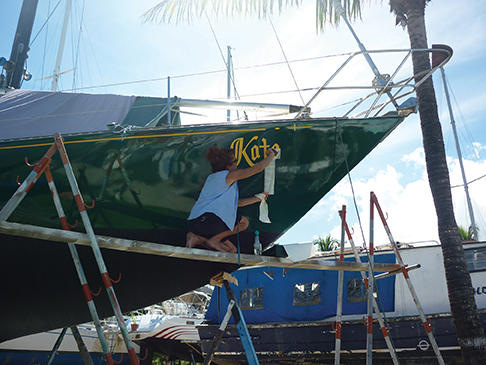
Heather Francis is originally from Nova Scotia, Canada and has been sailing with her partner, Steven Hertik, on board their Newport 41 Kate since 2008. They have spent the last three years in the South Pacific. To follow their adventures log onto www.yachtkate.com.
Vuda Point Marina
At full capacity the marina has 78 berths in the water, with a minimum depth at low tide of three meters in the basin and two and a half meters in the entrance channel. Thirty five cyclone holes are available for in ground storage for monohulls during the cyclone season. Recent improvements at the marina include new lifting slings and tires for the 63T WISE travel lift, upgrades to the fire safety equipment throughout the marina, and, as of September 2012, Vuda Point Marina now offers Customs and Immigration clearance for vessels. For more information log on to www.vudapointmarina.com.
Fiji Customs and Immigration officials are very helpful and friendly but are strict about the rules and regulations governing visiting vessels. When interacting with government officials it is best to dress smart casual and show respect.
Vessels are required to give a minimum of 48 hour’s notice to Fiji Customs prior to arrival. Upon entering Fijian waters, vessels must clear into the nearest official Port of Entry before stopping at any other port. A listing of ports can be found at www.fijiports.com.fj. For information about Advanced Notice of Arrival Forms, Customs regulations and Duty Free allowances log onto www.frca.org.fj. For VISA and immigration guidelines visit www.immigration.gov.fj.
















